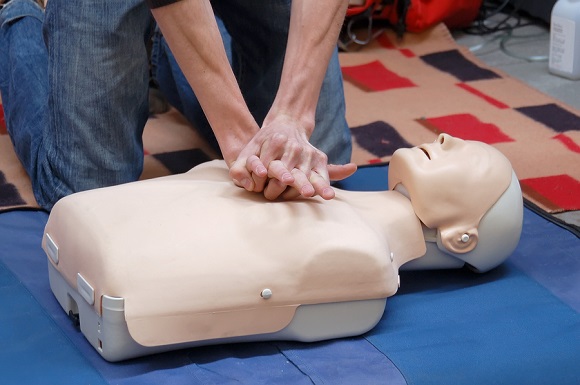 Movies, television, and outrageous false articles on social media have helped create a few very inaccurate perceptions about both CPR and survival rates. In this article, we’ll highlight a few of the common myths associated with cardiopulmonary resuscitation and try to dispel some of the confusion surrounding this sensitive topic.
Movies, television, and outrageous false articles on social media have helped create a few very inaccurate perceptions about both CPR and survival rates. In this article, we’ll highlight a few of the common myths associated with cardiopulmonary resuscitation and try to dispel some of the confusion surrounding this sensitive topic.
CPR for Laypeople
If you’re in a pinch, don’t have any training, and need to give someone CPR, call 9-1-1. The operator will walk you through the process. The most important thing is that chest compressions begin as soon as possible. Don’t worry about hurting the person. Lock your hands and push down on the victim’s chest to the beat of Staying Alive.
At least some of Hollywood is helping to educate people on the correct way to give CPR! Here’s a quick walkthrough from British Actor Vinnie Jones (just be sure to dial 9-1-1 in an emergency, not the British emergency number listed in this video):
7 Most Commonly Confused Realities About CPR
- Mouth the Mouth Is ALWAYS Necessary: FALSE! While rescue breathing is necessary in some instances, like with drug overdose or drowned victim, studies show that chest compressions is all you need to help a victim suffering from cardiac arrest.
- You Can’t Be Sued for Performing CPR: FALSE! You can get sued for nearly anything in this country; HOWEVER, the majority of states in the U.S. have passed Good Samaritan Laws that protect people who are trying to help other, which typically includes giving CPR. Check your state’s laws to figure out if you’re protected.
- CPR Works Most of the Time: Sadly, this is FALSE. In movies and television, CPR successfully resuscitates Hollywood victims about 60% of the time. According to a study by the American Heart Association, only about 10% of people suffering from sudden cardiac arrest that get immediate CPR end up surviving, though the more frequent use of AEDs is helping to improve survival rates.
- It is Illegal to Perform CPR without a License: FALSE. You don’t have to hold a CPR certification to give a victim CPR, but you should have a basic understanding of what you’re doing before getting started. 9-1-1 rescue operators walk people through this process all the time.
- If Certified in CPR, You Are Required to Help in an Emergency: FALSE. There are a few states that issue fines to bystanders for not helping in an emergency, but there are no laws that would force a person to give CPR to person in need. Though, we hope this would never be an issue.
- The Defibrillator Rub before Shocking a Victim: FALSE! Rubbing defibrillator paddles together before shocking a victim isn’t something medical professionals actually do.
- Shocking a Flat Lined Person Will Bring Them Back to Life: FALSE! Again, this only happens in Hollywood. In reality, you don’t shock a victim that has completely flatlined, you give them CPR. If you’re using an AED, the device will tell you if the victim can be shocked or not, which helps avoid confusion.
 Training Is the Best Way to Learn How to Perform CPR Correctly
Training Is the Best Way to Learn How to Perform CPR Correctly
We offer a range of CPR Training programs, which vary from simple CPR & First Aid classes to training for Advanced Healthcare Providers and even CPR trainers. We also provide a range of corporate CPR classes to help companies educate their workforce about CPR and stay in compliance with OSHA and other regulatory obligations.
Contact us to learn more about our CPR classes, corporate CPR Training programs, and various training programs for nurses and healthcare professionals.
Get CPR Training Today!
